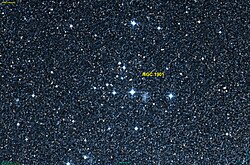
Messier 73 is an asterism of four stars in the constellation Aquarius. It lies several arcminutes east of globular cluster M72. According to Gaia EDR3, the stars are 1030±9, 1249±10, 2170±22, and 2290±24 light-years from the Sun, with the second being a binary star.
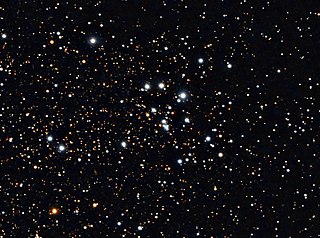
Messier 18 or M18, also designated NGC 6613 and sometimes known as the Black Swan Cluster, is an open cluster of stars in the constellation Sagittarius. It was discovered by Charles Messier in 1764 and included in his list of comet-like objects. From the perspective of Earth, M18 is situated between the Omega Nebula (M17) and the Small Sagittarius Star Cloud (M24).

Messier 52 or M52, also known as NGC 7654 or the Scorpion Cluster, is an open cluster of stars in the highly northern constellation of Cassiopeia. It was discovered by Charles Messier in 1774. It can be seen from Earth under a good night sky with binoculars. The brightness of the cluster is influenced by extinction, which is stronger in the southern half. Its metallicity is somewhat below that of the Sun, and is estimated to be [Fe/H] = −0.05 ± 0.01.

Messier 67 and sometimes called the King Cobra Cluster or the Golden Eye Cluster is an open cluster in the southern, equatorial half of Cancer. It was discovered by Johann Gottfried Koehler in 1779. Estimates of its age range between 3.2 and 5 billion years. Distance estimates are likewise varied, but typically are 800–900 parsecs (2,600–2,900 ly). Estimates of 855, 840, and 815 pc were established via binary star modelling and infrared color-magnitude diagram fitting.

Phi Aurigae, Latinized from φ Aurigae, is a giant star in the northern constellation of Auriga. It is faintly visible to the naked eye with an apparent visual magnitude of 5.089. It lies 10′ from another faint naked-eye star HD 35520, between the three open clusters M36 and M38, and NGC 1893.

NGC 2547 is a southern open cluster in Vela, discovered by Nicolas Louis de Lacaille in 1751 from South Africa. The star cluster is young with an age of 20-30 million years.

Phi Cassiopeiae is a multiple star in the constellation Cassiopeia with a combined apparent magnitude of +4.95. The two brightest components are A and C, sometimes called φ1 and φ2 Cas. φ Cas A is an F0 bright supergiant of magnitude 4.95 and φ Cas C is a 7.08 magnitude B6 supergiant at 134".

NGC 6530 is a young open cluster of stars in the southern constellation of Sagittarius, located some 4,300 light years from the Sun. It exists within the H II region known as the Lagoon Nebula, or Messier 8, and spans an angular diameter of 14.0′. The nebulosity was first discovered by G. B. Hodierna prior to 1654, then re-discovered by J. Flamsteed circa 1680. It was P. Loys who classified it as a cluster in 1746, as he could only resolve stars. The following year, G. Le Gentil determined it was both a nebula and a cluster.

NGC 2374 is an open cluster of stars in the Canis Major constellation. It was discovered on January 31, 1785 by the German-British astronomer William Herschel. This cluster is relatively rich in stars but is scattered across an angular diameter of 19.0′. It has an integrated visual magnitude of 8.0 and can be viewed with a modest amateur telescope. NGC 2374 is located at a distance of approximately 3,950 light-years (1,212 pc) from the Sun.

Eta Chamaeleontis, Latinized from η Chamaeleontis, is a star in the constellation Chamaeleon. It has an apparent magnitude of about 5.5, meaning that it is just barely visible to the naked eye. Based upon parallax measurements, this star is located some 325 light-years light years away from the Sun.

NGC 5617 is an open cluster in the constellation Centaurus. NGC 5617 forms a binary open cluster with Trumpler 22. It lies one degree west-northwest of Alpha Centauri.

NGC 4349 is an open cluster in the constellation Crux. It was discovered by James Dunlop in 1826. It is located approximately 7,000 light years away from Earth.
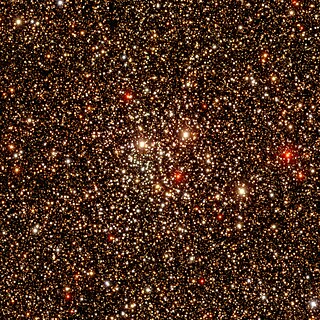
NGC 4815 is an open cluster in the constellation Musca. It was discovered by John Herschel in 1834. It is located approximately 10,000 light years away from Earth.
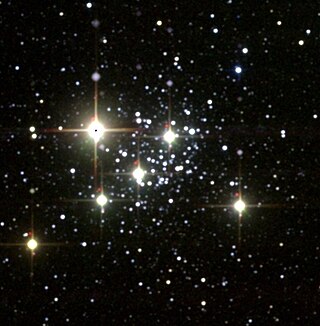
NGC 7419 is an open cluster in the constellation Cepheus. It is heavily reddened and notable for containing five red supergiants, the highest number known in any cluster until the end of the 20th century, but probably no blue supergiants.
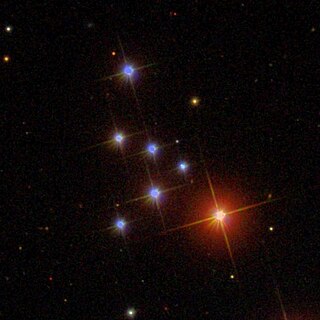
NGC 7772 is collection of stars in the constellation Pegasus that were thought to be an open cluster. The stars were first recorded on 7 October 1825 by the British astronomer John Herschel. Gaia data shows stars in the area are unrelated.

NGC 2266 is an open cluster of stars in the constellation of Gemini. It was discovered by German-British astronomer William Herschel on 7 December 1785. This is a relatively dim cluster with an integrated visual magnitude of 9.5 and an angular size of 5.0′. The stellar members can be readily resolved with an amateur telescope. NGC 2266 is located at a distance of 10,603 ly (3,251.0 pc) from the Sun. It is located close to the opposite part of the sky from the Galactic Center, or the anti-center.

NGC 2527 is an open cluster in the constellation Puppis. It was discovered by William Herschel on December 9, 1784. The cluster was also observed by John Herschel on January 7, 1831. He also observed it on February 5, 1837, identifying it as a different object, which was catalogued as NGC 2520. It is a poor cluster and with no central concentration, with Trumpler class III1p.

NGC 1193 is an open cluster in the Perseus constellation. It was first observed and catalogued by astronomer William Herschel in 1786. The cluster is estimated to be approximately 4.2 billion years old.

NGC 2420 is an open cluster in the constellation Gemini. It was discovered by William Herschel in 1783. The cluster is about two billion years old and it is located 10,000 light years away.
